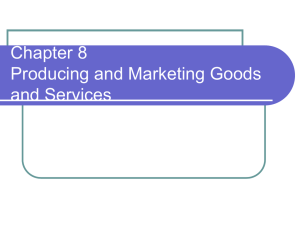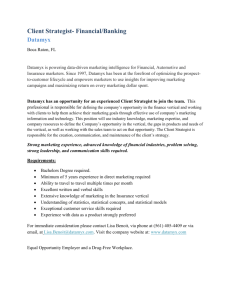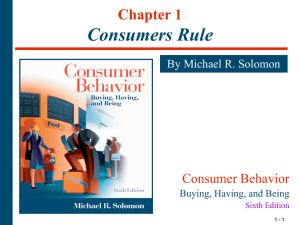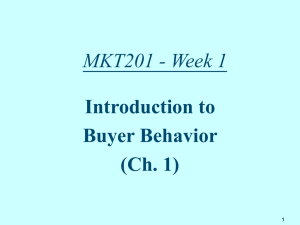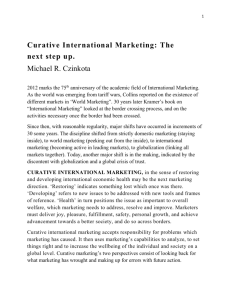motivation and values - College of Health and Human Sciences
advertisement
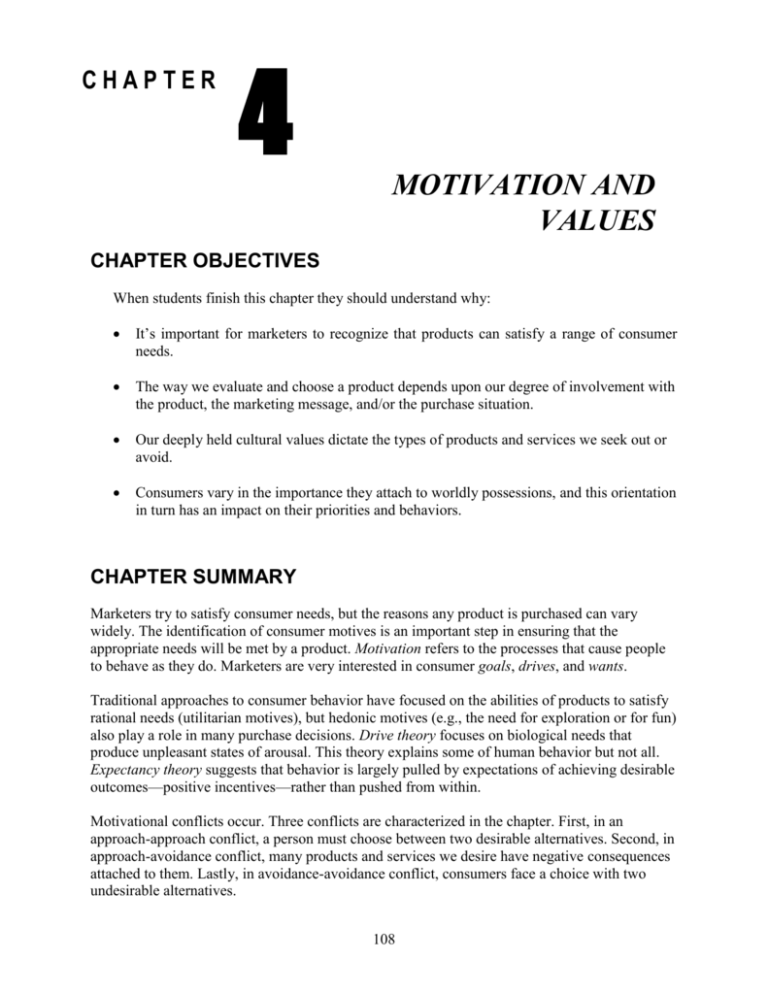
CHAPTER 4 MOTIVATION AND VALUES CHAPTER OBJECTIVES When students finish this chapter they should understand why: It’s important for marketers to recognize that products can satisfy a range of consumer needs. The way we evaluate and choose a product depends upon our degree of involvement with the product, the marketing message, and/or the purchase situation. Our deeply held cultural values dictate the types of products and services we seek out or avoid. Consumers vary in the importance they attach to worldly possessions, and this orientation in turn has an impact on their priorities and behaviors. CHAPTER SUMMARY Marketers try to satisfy consumer needs, but the reasons any product is purchased can vary widely. The identification of consumer motives is an important step in ensuring that the appropriate needs will be met by a product. Motivation refers to the processes that cause people to behave as they do. Marketers are very interested in consumer goals, drives, and wants. Traditional approaches to consumer behavior have focused on the abilities of products to satisfy rational needs (utilitarian motives), but hedonic motives (e.g., the need for exploration or for fun) also play a role in many purchase decisions. Drive theory focuses on biological needs that produce unpleasant states of arousal. This theory explains some of human behavior but not all. Expectancy theory suggests that behavior is largely pulled by expectations of achieving desirable outcomes—positive incentives—rather than pushed from within. Motivational conflicts occur. Three conflicts are characterized in the chapter. First, in an approach-approach conflict, a person must choose between two desirable alternatives. Second, in approach-avoidance conflict, many products and services we desire have negative consequences attached to them. Lastly, in avoidance-avoidance conflict, consumers face a choice with two undesirable alternatives. 108 Chapter 4: Motivation and Values As demonstrated by Maslow’s hierarchy of needs, the same product can satisfy different needs, depending upon the consumer’s state at the time. In addition to the consumer’s objective situation (i.e., whenever basic physiological needs have already been satisfied), the consumer’s degree of involvement with the product must be considered. A fact of the marketplace is that not all consumers are motivated to the same extent. Involvement refers to the level of perceived personal importance and/or interest evoked by a stimulus (or stimuli) within a specific situation. Involvement has many faces. Included in these are product involvement, message-response involvement, and purchase situation involvement. Degree of involvement becomes a means by which to segment a market and, therefore, devise strategies to reach different involved segments. Consumer motivations are often driven by underlying values. In this context, products take on meaning because they are seen as being instrumental in helping the person to achieve some goal that is linked to a value (such as individuality or freedom). Numerous forms of values are examined in the chapter. Also examined are scales that measure the shift in values over time. This chapter concludes with an examination of the impact that the events of September 11, 2001, had on societal values. CHAPTER OUTLINE 1. The Motivation Process a. Motivation refers to the processes that cause people to behave as they do. Once a need has been activated, a state of tension exists that drives the consumer to attempt to reduce or eliminate the need. b. Needs can be: 1) Utilitarian—a desire to achieve some functional or practical benefit. 2) Hedonic—an experiential need, involving emotional responses or fantasies. c. The desired end state is the consumer’s goal. Marketers try to create products and services that will provide the desired benefits and permit the consumer to reduce this tension. d. With the consideration of unmet needs, a discrepancy exists between the consumer’s present state and some ideal state. Tension is created. The consumer seeks to reduce tension. The degree of arousal is called a drive. e. Personal and cultural factors combine to create a want. This is one manifestation of a need. 1) Once a goal is attained, tension is reduced and the motivation recedes. 2) Motivation can be described in terms of: a) Its strength. b) Its direction. Discussion Opportunity—Ask: Pretend you are to explain motivation to a friend. What would you say? What examples would you use? (Do the same substituting goal, drive, and want.) 109 Section 2: Consumers as Individuals Discussion Opportunity—Bring in examples of magazine ads that demonstrate an attempt to activate (a) a utilitarian need or (b) a hedonic need. 2. Motivational Strength a. The degree to which a person is willing to expend energy to reach one goal as opposed to another reflects his or her underlying motivation to attain that goal. Biological Versus Learned Needs b. Early work on motivation ascribed behavior to instinct (the innate patterns of behavior that is universal in a species). When an instinct is inferred from the behavior it is supposed to explain, this circular explanation is called tautology. c. Drive theory focuses on biological needs that produce unpleasant states of arousal. 1) Tension reduction has been proposed as a basic mechanism governing human behavior. 2) Homeostasis—goal-oriented behavior that attempts to reduce or eliminate an unpleasant state and return to a balanced one. 3) Drive theory runs into difficulty when it tries to explain why people sometimes do things that might increase a drive state (such as delaying gratification). d. Expectancy theory suggests that behavior is largely pulled by expectations of achieving desirable outcomes—positive incentives—rather than pushed from within. Discussion Opportunity—Ask: Can you think of purchase situations that illustrate drive theory and expectancy theory? Which one of the theories do you think is superior? Discussion Opportunity—If a car of tourists drives into an unfamiliar town at meal time and stops at McDonald’s instead of an equally attractive and price-competitive JOE’S Eats, which of the two theories (expectancy or drive) would probably be at work? How would JOE’S combat this? 3. Motivational Direction a. Motives have direction as well as strength. Most goals can be reached by a number of paths. Needs Versus Wants b. The specific way a need is satisfied depends on the individual’s unique history, learning experiences, and his or her cultural environment. 1) The particular form of consumption used to satisfy a need is termed a want. Types of Needs c. Needs can be: 1) Biogenic needs—food, water, air, and shelter. 2) Psychogenic needs—power, status, affiliation. 3) Utilitarian needs—emphasizes objective, tangible attributes (miles per gallon). 4) Hedonic needs—subjective and experiential (excitement, self-confidence, fantasy). 110 Chapter 4: Motivation and Values Discussion Opportunity—Ask: What is a product or service you could purchase to fulfill a psychogenic need? Utilitarian need? Hedonic need? How would a marketer advertise to you with respect to fulfilling these needs? How would you know that you had fulfilled the need? Motivational Conflicts d. A goal has valence, which means that it can be positive or negative. Therefore goals can be sought or avoided. 1) Not all behavior is motivated by the desire to approach a goal. 2) Consumers often find themselves in situations in which different motives, both positive and negative, conflict with one another. Discussion Opportunity—Think of goals that are sought and those that are not. Share some examples with the students. Discussion Opportunity—Give an illustration of when motives conflict with one another in purchasing situations. Ask: Can anyone think of another example of when motives conflict? e. Conflicts can occur. Three different types of goal conflicts are: 1) Approach-approach conflict—a person must choose between two desirable alternatives such as choosing between two favorite brands of automobiles. a) The theory of cognitive dissonance is based on the premise that people have a need for order and consistency in their lives and that a state of tension is created when beliefs or behaviors conflict with one another. b) People attempt to reduce dissonance. c) A state of dissonance exists when there is a psychological inconsistency between two or more beliefs or behaviors. Discussion Opportunity—Ask: How could a marketer use theory of cognitive dissonance to their advantage? What do you think of Miller’s classic “Tastes Great, Less Filling” campaign? 2) Approach-avoidance conflict—many products or services we desire have negative consequences attached to them. An example is having to undergo a root canal procedure in order to rectify tooth decay. 3) Avoidance-avoidance conflict—a choice between two undesirable alternatives such as having to spend more on an older car or buy a newer more expensive car. *****Use Figure 4.1 Here ***** Discussion Opportunity—Give an illustration of each of the three major forms of conflict. You might even find examples of advertisements that demonstrate the three conflict situations. Ask: How can marketers use these conflicts to their advantage? 111 Section 2: Consumers as Individuals Classifying Consumer Needs f. Much research has been done on classifying human needs. 1) Various universal need classifications have been attempted. 2) There seems to be no universally accepted list (though many needs are common to all lists). a) Murray’s twenty psychogenic needs such as the need for autonomy, defendency, etc. g. Those needs that seem particularly relevant to buying behavior include: 1) Need for achievement. 2) Need for affiliation. 3) Need for power. 4) Need for uniqueness. h. Maslow’s hierarchy of needs implies that the order of development is fixed. This hierarchy is most closely associated with product benefits that people might be looking for. Lower order needs must be satisfied before climbing the needs ladder. The needs are: 1) Physiological. 2) Safety. 3) Social. 4) Esteem. 5) Self-actualization. *****Use Figure 4.2 Here ***** i. Problems with Maslow’s method include: 1) Climbing the ladder is not set in stone. Some activities cover several levels of needs. 2) The hierarchy may be culture-bound. 3) Consumer’s have different needs priorities at different stages of their life. *****Use Consumer Behavior Challenge #6 Here ***** Discussion Opportunity—(a) Tell the class about a product you could buy that could fit into all five levels of Maslow’s hierarchy of needs; (b) Bring an advertisement to class that demonstrates each one of the needs (you may have to bring five ads). 4. Consumer Involvement a. Involvement refers to “a person’s perceived relevance of the object based on their inherent needs, values, and interests.” 1) Involvement can be viewed as the motivation to process information. 2) As involvement increases, people devote more attention to ads related to the product, exert more cognitive effort to understand these ads, and focus their attention on the product-related information in them. *****Use Figure 4.3 Here ***** 112 Chapter 4: Motivation and Values Discussion Opportunity—Ask: Who can give me an example of involvement with a product category or brand? How can marketers use involvement to construct advertising campaigns? Levels of Involvement: From Inertia to Passion b. The type of information processing that will occur depends upon the consumer’s level of involvement. It can range from simple to elaborate processing. 1) Simple processing—only basic features of a message are considered. 2) Elaboration—information is linked to one’s preexisting knowledge systems. c. Because a person’s degree of involvement can be conceived as a continuum, consumption at the low end of involvement is characterized by inertia. 1) In this state, decisions are made out of habit because the consumer lacks the information to consider alternatives. 2) To the contrary, decisions can be very passionate and carry great meaning for a person. 3) In consumer situations of high involvement, the consumer enters a flow state, where the consumer is in an elated state of focus and concentration and loses track of time. d. Cult products command fierce consumer loyalty, devotion, even worship. *****Use Consumer Behavior Challenge #5 Here ***** Discussion Opportunity—Ask the class to think of a time when they purchased something based on the concept of inertia or passion. Have students share what they thought of. The Many Faces of Involvement d. Involvement can be cognitive or emotional. There are several types of broad involvement: 1) Product involvement is related to a consumer’s level of interest in a particular product. Sales promotions increase this involvement. A powerful way to enhance product involvement is through mass customization. 2) Message-response involvement (or advertising involvement), refers to the consumer’s interest in processing marketing communications. Vigilante marketing, where freelancers and fans film their own commercials for favorite products and post them on Web sites, is a hot trend. a) Television is considered a low-involvement medium. b) Print is considered a high-involvement medium. c) In this digital age, the quest to heighten message involvement is fueling the rapid growth of interactive mobile marketing, where consumers participate in real-time promotional campaigns via their cell phones or PDA’s. 3) Purchase-situation involvement refers to differences that may occur when buying the same object for different contexts. Social risk is considered. Discussion Opportunity—Illustrate each of the “faces of involvement.” How would marketers make appeals in these areas? Provide illustrations of when “gift giving” might fall under each of the involvement situations. 113 Section 2: Consumers as Individuals 5. Measuring and Enhancing Involvement a. Measurement of involvement is important for a variety of reasons. 1) An involvement profile can be constructed using the following components: a) Personal interest in a product category. b) Perceived importance of the potential negative consequences associated with a poor product choice. c) The probability of making a bad purchase. d) The pleasure value of the product category. e) The sign value of the product category. *****Use Table 4.1 and Table 4.2 Here ***** Discussion Opportunity—Create a handout using the consumer involvement scale in Table 4.1 to measure involvement of two or three different products. Have the students quickly respond to the scale and total their scores. Ask for general ranges of scores for each product or have specific students share their scores. Encourage students to discuss the results and whether or not they accurately describe how they feel about each product. Discussion Opportunity—Ask: What are some products that people buy that seem to require a great deal of involvement? 2) It is possible to segment by involvement levels. There is diversity among involvement groups. 3) There are specific strategies that can be used to increase involvement. a) Appeal to hedonic needs (sensory appeals). b) Use novel stimuli (cinematography, sudden silences, or unexpected movements in commercials). c) Use prominent stimuli (loud music, large ads, color, or fast action). d) Include celebrity endorsers. e) Build a bond with the consumer (relationship marketing—example, R. J. Reynolds Tobacco). *****Use Consumer Behavior Challenges #8 and #5 (Used Previously) Here ***** Discussion Opportunity—Construct and then discuss an example of market segmentation based on involvement. Consumer-Generated Content Thanks to the Internet-based interactivity, people are able to voice their opinions about products, brands, and companies on blogs, podcasts, and social networking sites such as facebook.com or myspace.com. Beyond text-based messages, consumers are able to generate videos and showcase them at YouTube.com. All of this is seen as the upgrading of the Internet experience (also called Web 2.0) as a social and interactive medium. These changes are forcing marketers to “share” ownership of their brands with users although not always in a positive way. 114 Chapter 4: Motivation and Values Values b. A value is a belief that some condition is preferable to its opposite. 1) Two people can believe in the same behaviors but their underlying belief systems may be quite different. 2) Consumers often seek out those that have similar belief systems to their own. Discussion Opportunity—Ask students to share examples of how people with similar values band together. Bring in some example ads illustrating this concept. Core Values c. Every culture has a set of core values that it imparts to its members. Core values do change over time. In many cases, values are universal. 1) What sets cultures apart is the relative importance or ranking of universal values. This set of rankings is a culture’s value system. 2) Every culture is characterized by its members’ endorsement of a value system. 3) Each set of core values that uniquely define a culture is taught to that culture by socialization agents (parents, friends, and teachers). a) The process of learning the beliefs and behaviors endorsed by one’s own culture is termed enculturation. b) Acculturation is the process of learning the value system and behaviors of another culture. Discussion Opportunity—Ask: What are some values that are important to you? Which of these values are transferred to your purchase behavior? In what way? How Values link to Consumer Behavior d. Despite their importance, values have not been as widely applied to direct examination of consumer behavior as might be expected. The reason is that many values are very general or relative by nature (e.g., freedom, security, inner peace). Because values drive much of consumer behavior, it could be said that virtually all consumer research is ultimately related to the identification and measurement of values. 1) Research has tended to classify values as being: a) Cultural Values (such as security). b) Consumption-specific (such as convenient shopping or prompt service). c) Product-specific (such as ease of use or durability). 2) Research in values: a) The Rokeach Value Survey—the psychologist Milton Rokeach identified two sets of values: 1. Terminal values—desired end-states that apply to many different cultures. 2. Instrumental values—composed of actions needed to achieve these terminal values. 115 Section 2: Consumers as Individuals *****Use Table 4.3 Here ***** Discussion Opportunity—Provide an example that illustrates terminal values and instrumental values. How do these values relate to advertising attempts to influence behavior? b) The List of Values (LOV)—identifies nine consumer segments based on the values they endorse (and then relates these to consumption). c) The Means-End Chain Model—specific product attributes are linked at increasing abstraction to terminal values via “laddering.” Laddering is a technique whereby consumers’ associations between specific attributes and general consequences are uncovered. *****Use Figure 4.4 Here***** Discussion Opportunity—Provide an illustration of the means-end chain model. Comment on applications and usefulness of the model. d) Syndicated Surveys—a variety of surveys are available. 1. The Yankelovich Monitor attempts to track changes in values over time. 2. This survey identifies voluntary simplifiers as consumers who believe that once basic needs are met, additional income will not add to happiness. 3. Modern syndicated surveys that track changes in values are VALS2, GlobalScan, New Wave, and the Lifestyles Study. *****Use Table 4.4 Here; Use Consumer Behavior Challenge #2 Here ***** Sustainability: A New American Core Value? American consumers’ focus on personal health is merging with growing interest in global health. Analysts call this new value conscientious consumerism. Marketers feel that consumers who practice LOHAS (lifestyle of health and sustainability) is driving this change and they are responding with eco-friendly products and programs. Beyond participating in recycling programs, these consumers are now “voting with their forks” by demanding local, hormone-free, organic, cage-free, types of produce and products that do not harm animals. There seems to be a level of realization about the impact of human activity on the health of planet earth. With all the discussions and debates about global warming, the focus is on the carbon footprint, the measure of emissions of carbon dioxide and other greenhouse gases as a result of human activity. Materialism: “He Who Dies with the Most Toys, Wins . . .” e. Materialism refers to the importance people attach to worldly possessions. 1) America is a highly materialistic society. 116 Chapter 4: Motivation and Values 2) Materialists are more likely to value possessions for their status and appearance-related meanings. *****Use Consumer Behavior Challenge #1 Here ***** Discussion Opportunity—What is your opinion on materialism? Is it good or bad? Be careful how you answer this. How do marketers use materialism to their advantage? What is the alternative to materialism? Would this be good for our economy? End-of-Chapter Support Material SUMMARY OF SPECIAL FEATURE BOXES 1. Marketing Pitfalls I This box focuses on the downside of allowing consumers to take control of brand campaigns. In the case of the Chevy experiment, consumers refocused the message and positioned the product as eco-detrimental. 2. Marketing Pitfalls II This box highlights the difficulty that some brands encounter selling in other countries and cultures. The product or its application might be too personal or sensitive in certain cultures. But it is possible for these products and their designs to evolve over time and win over consumers REVIEW QUESTIONS 1. What is motivation, and how is this idea relevant to marketing? Motivation refers to the processes that lead people to behave as they do. It occurs when a need is aroused that the consumer wishes to satisfy. Once a need has been activated, a state of tension exists that drives the consumer to attempt to reduce or eliminate the need. Marketers try to create products and services that will provide the desired benefits and permit the consumer to reduce this tension. 2. Describe three types of motivational conflicts, citing an example of each from current marketing campaigns. In an approach–approach conflict, a person must choose between two desirable alternatives. A student might be torn between going home for the holidays and going on a skiing trip with friends. Many of the products and services we desire have negative consequences attached to them as well. We may feel guilty or ostentatious when 117 Section 2: Consumers as Individuals buying a status-laden product such as a fur coat, or we might feel like a glutton when contemplating a tempting package of Twinkies. An approach–avoidance conflict exists when we desire a goal but wish to avoid it at the same time. Sometimes consumers find themselves “caught between a rock and a hard place.” They may face a choice with two undesirable alternatives, for instance, the option of either throwing more money into an old car or buying a new one. Marketers frequently address an avoidance–avoidance conflict with messages that stress the unforeseen benefits of choosing one option (e.g., by emphasizing special credit plans to ease the pain of car payments). 3. Explain the difference between a need and a want. The specific way a need is satisfied depends on the individual’s unique history, learning experiences, and cultural environment. A want is the particular form of consumption used to satisfy a need. For example, two classmates may feel their stomachs rumbling during a lunchtime lecture. If neither person has eaten since the night before, the strength of their respective needs (hunger) would be about the same. However, the ways each person goes about satisfying this need might be quite different. 4. What is cognitive dissonance? The theory of cognitive dissonance is based on the premise that people have a need for order and consistency in their lives and that a state of tension is created when beliefs or behaviors conflict with one another. The conflict that arises when choosing between two alternatives may be resolved through a process of cognitive dissonance reduction, where people are motivated to reduce this inconsistency (or dissonance) and thus eliminate unpleasant tension. 5. Name the levels in Maslow’s hierarchy of needs, and give an example of a marketing appeal that is focused at each level. Physiological: “I like to work in the soil.” Safety: “I feel safe in the garden.” Social: “I can share my produce with others.” Esteem: “I can create something of beauty.” Self-actualization: “My garden gives me a sense of peace.” 6. What is consumer involvement? How does this concept relate to motivation? We can define involvement as “a person’s perceived relevance of the object based on their inherent needs, values, and interests.” The word object is used in the generic sense and refers to a product (or a brand), an advertisement, or a purchase situation. Consumers can find involvement in all these objects. 7. Why would marketers want their customers to enter into a flow state when shopping for their products? When consumers are truly involved with a product, an ad, or a Web site, they enter what a flow state. This state is the Holy Grail of Web designers who want to create sites that are so entrancing the surfer loses all track of time as he becomes engrossed in the site’s contents (and hopefully buys stuff in the process!). 118 Chapter 4: Motivation and Values 8. List three types of consumer involvement, giving an example of each type. 1. Product involvement refers to a consumer’s level of interest in a particular product. Many sales promotions are designed to increase this type of involvement. When Lifesavers announced that it was going to eliminate the pineapple flavor unless consumers went to its Web site and voted to keep it, over 400,000 consumers heard the call and saved the flavor. 2. Vigilante marketing, where freelancers and fans film their own commercials for favorite products and post them on Web sites, is hot. In one unauthorized spot produced by a teacher that got media attention in magazines like Wired and on advertising blogs like AdRants, an iPod Mini zips around to the song "Tiny Machine" by the Darling Buds. This devotion to creating a commercial is an extreme example of message–response involvement (also known as advertising involvement) that refers to the consumer’s interest in processing marketing communications. 3. Purchase situation involvement refers to differences that may occur when buying the same object for different contexts. Here the person may perceive a great deal of social risk or none at all. For example, when you want to impress someone you may try to buy a brand with a certain image that you think reflects good taste. When you have to buy a gift for someone in an obligatory situation, like a wedding gift for a cousin you do not really like, you may not care what image the gift portrays. 9. What are some strategies marketers can use to increase consumers’ involvement with their products? Appeal to the consumers’ hedonic needs. For example, ads using sensory appeals generate higher levels of attention. Use novel stimuli, such as unusual cinematography, sudden silences, or unexpected movements in commercials. When a British firm called Egg Banking introduced a credit card to the French market, its ad agency created unusual commercials to make people question their assumptions. One ad stated “Cats always land on their paws,” and then two researchers in white lab coats dropped a kitten off a rooftop—never to see it again (animal rights activists were not amused). Use prominent stimuli, such as loud music and fast action, to capture attention in commercials. In print formats, larger ads increase attention. Also, viewers look longer at colored pictures as opposed to black and white. Include celebrity endorsers to generate higher interest in commercials. (We’ll discuss this strategy in Chapter 8.) Build a bond with consumers by maintaining an ongoing relationship with them. Learn from the actions of tobacco companies that have figured out how to keep smokers’ loyalties (at least until they die). R. J. Reynolds Co. hosted nearly 3,700 Doral smokers at its factory for Western line dancing lessons, bowling, blackjack, and plenty of free cigarettes. Said one happy attendee, “I’d quit altogether before I’d change brands.” Now there’s a thought. 119 Section 2: Consumers as Individuals 10. What are values, and why should marketers care? A value is a belief that some condition is preferable to its opposite. For example, it’s safe to assume that most people place a priority on freedom, preferring it to slavery. Others avidly pursue products and services that will make them look young, believing that this is preferable to appearing old. A person’s set of values plays a very important role in consumption activities. Consumers purchase many products and services because they believe these products will help to attain a value-related goal. 11. What is the difference between enculturation and acculturation? How do we figure out what a culture values? We term the process of learning the beliefs and behaviors endorsed by one’s own culture enculturation. In contrast, we call the process of learning the value system and behaviors of another culture (often a priority for those who wish to understand consumers and markets in foreign countries) acculturation. 12. What are LOHAS, and why are they important? Some American marketers are starting to focus on a potentially huge value segment they are calling LOHAS—an acronym for “lifestyles of health and sustainability.” This label refers to people who worry about the environment, want products to be produced in a sustainable way and who spend money to advance what they see as their personal development and potential. These consumers represent a great market for products such as organic foods, energy-efficient appliances and hybrid cars as well as alternative medicine, yoga tapes, and eco-tourism. 13. Describe at least two alternative techniques marketing researchers have used to measure values. 14. The Rokeach Value Survey. The psychologist Milton Rokeach identified a set of terminal values, or desired end states, that apply to many different cultures. The Rokeach Value Survey, a scale used to measure these values, also includes a set of instrumental values, which are composed of actions needed to achieve these terminal values. The List of Values (LOV) Scale was developed to isolate values with more direct marketing applications. This instrument identifies nine consumer segments based on the values they endorse and relates each value to differences in consumption behaviors. These segments include consumers who place a priority on such values as a sense of belonging, excitement, warm relationships with others, and security. Means-end Chain. Another research approach that incorporates values is termed a means–end chain model. This approach assumes that very specific product attributes are linked at levels of increasing abstraction to terminal values. The person has valued end states, and he or she chooses among alternative means to attain these goals. Products are thus valued as the means to an end. Syndicated survey. A number of companies track changes in values through largescale surveys. They sell the results of these studies to marketers, who often also pay a fee to receive regular updates on changes and trends. What is the value of materialism? Materialism refers to the importance people attach to worldly possessions. We sometimes take the bounty of products and services for granted, 120 Chapter 4: Motivation and Values until we remember how recent this abundance is. For example, in 1950 two of five American homes did not have a telephone, and in 1940 half of all households still did not possess complete indoor plumbing. CONSUMER BEHAVIOR CHALLENGE Discussion Questions 1. “College students’ concerns about the environment and vegetarianism are just a passing fad: a way to look ‘cool.’ ” Do you agree? Students will have mixed views about this subject. What they need to see is that a fad that lasts for some length of time becomes a value (or is at least tied to values). For example, is the trend toward not smoking a value or a fad? The value might be healthy living or avoidance of what is now considered to be a nasty habit. The result is not smoking. Those who smoke might not only do it because they like it but as a way to be peer accepted or make a nonconformity statement (or to shock their parents and other authority figures). Ask students for their feelings about these subjects. How can the marketer capitalize on these “value” feelings? How do consumers reinforce their deep-seated values? 2. Some market analysts see a shift in values among young people. They claim that this generation has not had a lot of stability in their lives. They are fed up with superficial relationships and are yearning for a return to tradition. This change is reflected in attitudes toward marriage and family. One survey of 22- to 24-year-old women found that 82 percent thought motherhood was the most important job in the world. Brides magazine reports a swing toward traditional weddings—80 percent of brides today are tossing their garters; Daddy walks 78 percent of them down the aisle. What’s your take on this? Are young people indeed returning to the values of their parents (or even their grandparents)? How have these changes influenced your perspective on marriage and family? Various answers are likely to arise. When asked if they are returning to the values of their parents or grandparents, many students will shudder at that thought, regardless of how they might be leaning. The way that students respond to this question will depend very much on how they have been raised. The question itself asserts that “this generation” has not had stability in their lives. Although this may be true in many instances, it is also true that many students come from very stable homes. Additionally, students may recognize that they desire more traditional values in some ways (such as a traditional wedding), but not in others (such as cohabitating or desiring a dual-income home). 3. How do you think consumers have changed as a result of 9/11? Are these changes longterm or will we start to revert back to our pre-2001 mindset? 121 Section 2: Consumers as Individuals The text mentions various ways that consumer values have changed as a result of 9/11. There were short-term effects on air travel and hospitality that seem to have recovered (although the airline industries face other problems of their own). But as for more longterm effects, people have reacted in sometimes opposing ways. Television programming saw some impact in the demand for more programming reflecting traditional values. And yet, it can also be noted that there is a higher level of crime and violence programs, many reflecting terrorism themes. Post 9/11, there was a measurable change in the number of people focusing on more utilitarian goods rather than luxury goods. But at the same time, there were many subscribing to the “can’t take it with you” mentality, and have splurged even more than before. The effect that 9/11 continues to have on people and their consumer behavior likely has a great deal to do with personal views on the war on terror and how that is being handled by governments. 4. Core values evolve over time. What do you think are the three to five core values that best describe Americans now? This question could just as easily be applied to whatever country or society that serves as the base for the student body taking the course. Regardless, responses will likely differ between those who are natives and those who are foreign. As for the core values for the United States, the basics have been the same for quite some time. U.S. citizens are more individualistic than collectivistic (more importance placed on the individual than the overall group), more monochromic than polychromic (more importance placed on punctuality and schedules), and lower context than high context (communication depending less on context and more on literal text and spoken language). However, as far as trends that tend to come and go, the core values of Americans will likely vary depending on age, ethnicity, and other demographic factors. Some factors that may arise are health, environment, and public safety, among others. However, whether or not it is determined that consumer’s pay more or less attention to these issues will likely vary. Application Questions 5. Devise separate promotional strategies for an article of clothing, each of which stresses one of the levels of Maslow’s hierarchy of needs. Students should be encouraged to review Maslow’s hierarchy of needs, including physiological, safety, belongingness, esteem, and self-actualization. Although their selection of clothing articles for this exercise may be diverse, there is likely to be some consistency within need categories. Examples include: 1) the promotion of namebrand/designer-label clothing stressing consumers’ need to belong to a particular social group; 2) the promotion of warm and durable jackets or boots stressing consumer physiological need; 3) the promotion of protective equipment for amateur athletes (e.g., knee and elbow guards, helmets, and goggles) stressing consumers’ safety needs; 4) the promotion of elegant dress or a tux for esteem; and 5) anything you want to wear (like Sam Walton did) because clothes don’t matter that much to you. 122 Chapter 4: Motivation and Values 6. Collect a sample of ads that appear to appeal to consumers’ values. What value is being communicated in each ad, and how is this done? Is this an effective approach to designing a marketing communication? Encourage students to look at the types of values in either the Rokeach Value Survey or List of Values (LOV) to determine which consumer values they would like to share with the class. (Possible Field Project Idea) 7. Describe how a man’s level of involvement with his car would affect how he is influenced by different marketing stimuli. How might you design a strategy for a line of car batteries for a segment of low-involvement consumers, and how would this strategy differ from your attempts to reach a segment of men who are very involved in working on their cars? Different levels of involvement with a product influence the amount of attention paid to marketing stimuli, affecting the amount of cognitive processing capacity directed toward stimuli (e.g., the product related information in an ad). In discussing the development of advertising targeted at low-involvement consumers, students should recognize that peripheral cues are used in place of product-related information. Behaviors resulting from such cues do not last long and are likely to change over time. (Bobby Unser uses a Die-Hard battery!) Conversely, developing advertising directed toward high-involvement consumers will rely less on peripheral cues and more on substantial product-related information (i.e., the central route to persuasion). Behaviors resulting from this emphasis will be more resistant to change. (How many amps? How many minutes of reserve capacity? What are the cold cranking amps? What are the marine cranking amps?). 8. Interview members of a celebrity fan club. Describe their level of involvement with the “product,” and devise some marketing opportunities to reach this group. Student responses to this exercise might consider a variety of celebrities—movie stars, musicians, and politicians—living and dead. They might be asked to consider the Elvis Presley fan club phenomenon in terms of the tremendous marketing opportunities that have derived from tours of his home in Memphis (Graceland), his personal property displayed in “museums” (guitars, clothing, music awards, etc.), his “signature” hairstyle and sideburns, other actors’ and musicians’ remakes of his movies and songs, television programs, Elvis parades, books, postage stamps, etc. The quickest way to do this project is to “go online” to a “favorite site.” Most of the recognized search engines (e.g., Yahoo!) will have ways for you to reach the celebrity sites. (Possible Field Project Idea) 123 Section 2: Consumers as Individuals CASE STUDY TEACHING NOTES Chapter 4 Case Study: Campbell’s Soup on the Go Summary of Case Campbell’s Soup Company, under the direction of Chief Strategy Officer Carl Johnson, is in the midst of a major turnaround. The company that is synonymous with soup has struggled for growth for quite some time. But now, they are riding a wave of success based on a series of new product introductions. The product line highlighted in this case is the Soup at Hand line. These are soups that come in single-serving, contoured, microwaveable containers with a plastic sipping cap. They have been designed for to be sold through convenience stores for people to literally have a meal on the run. Suggestions for Presentation This case is clearly applicable to the various need-based concepts as taught in the text. The discussion questions for the case have positioned the case as such. But instructors should not overlook the relationship between values and needs. In this context of this case, what are the values that have changed in the United States that are making products such as these big hits, when they likely would have failed 20 or even 10 years ago? This is a perfect product to illustrate that people in the United States are working more (including dual-income homes) and have less time for things like eating and cooking. People are also multi-tasking (eat while you drive). Although much of this has been driven by the circumstances that people find themselves in, the discussion of this case should at least touch on the possibility that today’s high need for convenience has evolved and that consumers have likely been conditioned to want more and more convenience products. The case highlights the fact that opening a regular can of soup and heating it in a microwave container isn’t really any more difficult than heating up a Soup at Hand soup. But, consumers perceive a big difference. That’s why traditional canned soup sales are lagging, and products like these are taking off. Suggested Answers for Discussion Questions 1. What consumer needs are driving the success of products like Campbell’s Soup at Hand? Consider both biological and learned needs. Hunger and nourishment are biological needs. But of course, those can be satisfied by any number of products. This new era of on-the-go eatables is being driven by consumer’s need to save time. People are cooking at home less and less. But if one needs to eat out and eat quickly, why not go through a drive-thru? Evidently, there are plenty of people who have situations where even that takes too much time. Grabbing a soup while the car is filling up takes care of the need for quick nourishment. Putting it in the cup holder and eating while driving and talking on the cell phone ensures that eating has not taken a moment out of a person’s busy schedule. As mentioned above, there are also the learned needs that consumers pick up. Companies have responded to the need for 124 Chapter 4: Motivation and Values convenience with their products, but they have also taught us to want more and more convenience oriented products through offering innovations such as these. 2. Are some needs more powerful than others? Illustrate this by discussing the needs that customers might be sacrificing in order to satisfy other needs. This could be related to Maslow’s Hierarchy of Needs. Hunger is a base level need and a strong one at that. There are those that without a convenient way to eat on the go would not be able to satisfy the hunger need as often as they would like. Yet, proper nourishment is also a need, one that fits into the level of safety. Are consumers forgoing some health benefits with such products? How about taste? The case describes how the soups had to be modified in order to work in this packaging option. Evidently, some people have a stronger need for convenience than they do a need for the same soups that they are familiar with. Additional Support Material STUDENT PROJECTS Individual Projects 1. Ask students if they have provided opinions regarding products or brands on any Website. If yes, have them share it with the class. If not, let them visit a site to provide opinions about their most recent significant purchase. They can also go to eopinions.com and provide their input. 2. Ask students to have ten people describe the personality of one of the following products or another product of the students’ choosing: Mountain Dew; iPod; Buick; Prada; WalMart; a specific local restaurant or pub. How are the descriptions similar? How are they different? (This question might be done as an in-class activity, assigning each student to interview five different people within the class itself. Simply direct students to mingle about the room, pairing off with another person, and interviewing each other. Allow students to continue until each has interviewed at least five other people.) 3. Have students think of examples of products or services that each of them has purchased that fit the three types of motivational conflicts found in Figure 4.1. 4. Find a student who is not too shy to do this one. Ask the student to search for unconscious motives by asking six people if they are wearing perfume or cologne. Make sure they keep asking until at least three people say, “Yes.” Then have them ask the respondents, “Why do you wear cologne?” Ask three of those who said they were not wearing cologne, “Why not?” Ask the three who said, “No” if they wore any the last time they had a date. Share their responses with the class and evaluate them. Can the class uncover any hidden motivations? 125 Section 2: Consumers as Individuals 5. Ask students to come up with a list of products or services that people primarily buy because they want to “belong.” Have them explain why they listed the particular items. Then, have them explain how each of the items that they listed might also be consumed by individuals in solitude. Are there viable needs that consumers have for consuming these products both in the company of others as well as by themselves? 6. Have each student extensively describe a consumption situation that reflects each of the following: need for affiliation, need for power, and need for uniqueness. 7. Have students find advertisements that attempt to persuade consumers to think of products as objects that satisfy one of the motives described in this chapter. Have them identify and classify that motive. 8. Ask students to find a print ad that appeals to each level of Maslow’s hierarchy. In class, have different students show their ads and explain why their ads appeal to each level. Ask why they think the firm selected this particular appeal. Is there overlap between levels? Is this good or bad? 9. Have individual students construct an example of the means-end chain model for a specific product or brand. Explain the thought process used. Have your students think of some product or service they have purchased recently. Then have them respond to the consumer involvement scale in Table 4.1. Is their involvement with this product best described as product involvement, message-response involvement, or purchase situation involvement? Why? 10. 11. Have each student list what he or she perceives to be the five most important values themselves. To their parents. How do these values transfer to purchase decisions? How would marketers find out about their values? Group Projects 1. Recent political campaigns from both the major parties (Democrats and Republicans) had to endure voter-generated content in the form of debates based on question posed via YouTube.com. Have the groups visit YouTube.com and review the debates to evaluate if they feel that the quality of the voter-generated questions was similar to the traditional debates. 2. Assign groups of students to observe a table of people eating in either a restaurant or cafeteria setting. See if they can identify any of the major motives at work. Have them report on their conclusions. (Hint: Watch the respondents’ behavior while they eat and during their conversation. Perhaps students might like to videotape part of the meal—five minutes maximum). 126 Chapter 4: Motivation and Values 3. Have groups of students come up with three examples of a truly mass customized product. For each, have them give extensive reasons as to why consumers might choose the mass customized version of a product over the “off-the-rack” version. 4. Have the class keep a diary of their consumer decisions for a two-day period. (Make sure they include both actual purchases and conscious decisions not to buy.) At the end of the period have them review their diaries and classify their apparent motives. (Maslow’s scheme may be useful here.) During this process were they more aware of ads? Have students discuss their diaries in groups. 5. Have the group go to a shopping center or mall and observe others’ behavior. What conclusions can they make about motives, involvement, and values after having made the observation? 6. In a project related to #4, have groups of students visit a shopping mall or a superstore. Have them evaluate the retail environment for ways that both the retailer and product manufacturers try to increase consumer involvement (refer to text if necessary for strategies to increase involvement). 7. Have groups evaluate a purchase made by a teenager using roles or characteristics similar to those shown in Table 4.4. 8. Have groups assigned to several local businesses in two or three industries/sectors. The assignment involves interviewing the managers or decision makers about their efforts, if any, to go “green” and combat global warming. Write a report along with recommendations to facilitate greater efforts. eLAB Individual Assignments 1. This might hit close to home!! Ask students to visit RateMyProfessors.com or PicAProf.com or RateAProf.com or ProfRater.com and evaluate if the ratings help them in any way. Ask them to register and rate some of their professors!! 2. Visit a Website that includes a quiz or test of materialism (ex. http://www.expertrating.com/quizzes/Materialism-Test.asp or find it at Quizilla.com) and take the test to evaluate how materialistic you are. 3. Go to www.benjerry.com. Ben & Jerry’s Ice Cream is famous for a well-rounded mission statement and care and concern for the environment. What is their mission? What indications are there about the organization’s commitment to the environment? What 127 Section 2: Consumers as Individuals values does the company try to express? How might this expression help the organization market products? 4. Go to www.wholefoods.com. Take some time to become familiar with the Web site. Describe this company and the products that they offer. Select specific examples of products that seem to target the LOHAS values segment. Are these products that might appeal to values other than those described by LOHAS? 5. Go to www.burton.com. Burton Snowboards are very popular with Gen X. How does this Web site attempt to motivate consumers to try the sport and the Burton products? Be specific with the description of strategies that Burton uses. Do you think the Burton approach is effective? Explain. This project can also be done with Nike.com. 6. Go to http://shop.vans.com. Find the link for creating your own custom pair of Vans shoes. Go through the process and print an example of your shoes to take in to class and share. Describe the experience. Did the experience contribute to the level of involvement in shopping for such a product? 7. Go to www.specialized.com. Specialized Bicycles is one of the leading manufacturers and marketers of all types of bikes. Browse their Web site. Give a brief description of their different product lines. How does Specialized motivate consumers to get into biking? Are there any value statements made (either directly or indirectly)? Explain. What might Specialized do to improve the “motivation” aspect of their site (you might want to compare it to the Burton Snowboard site discussed previously)? 8. Go to www.gallup.com or www.pollingreport.com. What can we learn about consumer behavior from polls? What can we learn about motivation and values from polls? Participate in one of the polls available on the Web site. Project what might have been learned about your motivations or values by participating in the poll. Comment. Group Assignments 1. Visit a motivation Website such as GetMotivation.com or Motivation123.com. Many of these sites target personal motivation but are there techniques that marketers can learn in order to motivate consumers to buy a product/service or buy into a type of lifestyle? Write a report and present. 2. Have the students surf the Web and compile a list of Websites that provide user/consumer opinions on a variety of products targeted at typical students. This list can help other students get better educated about products and if possible published in the student newspaper at the university/college or their Website. 3. Go to www.sric-bi.com. Your group should explore the VALS, VALS2, and iVALS methods discussed on the Web site. Describe each of the methods. Pick one of the methods for further research. Have each group member take the VALS test online. What 128 Chapter 4: Motivation and Values were the results? Comment on these methods as a means to explore consumer values. Devise an experiment by which VALS studies could be used to explore consumer values. 4. Go to www.burningman.com. Become familiar with the purpose of this festival. As a group, discuss the extent to which it is possible to achieve the purposes set forth by this organization. Discuss the irony of this. 5. Visit a Website that includes a quiz or test of materialism (ex. http://www.expertrating.com/quizzes/Materialism-Test.asp or find it at Quizilla.com) and take the test to evaluate how materialistic you are. 129

